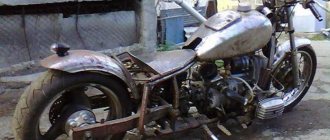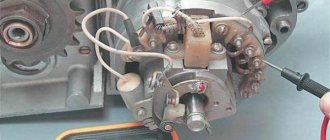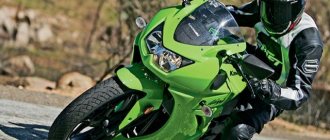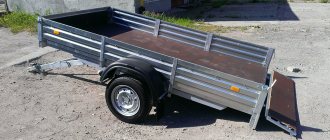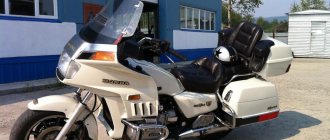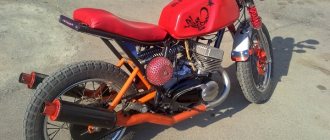The most popular domestic motorcycles were IZh bikes produced by the Izhevsk Machine-Building Plant; among them, the road version IZH Planet stood out - 5 tuning, which allowed the owner to get an individual motorcycle modified to suit his needs and desires, practically his own model.
The IZH Planet - 5 model replaced the IZH Planet 4 motorcycle on the assembly line in 1987 and was produced until 2008. The design of the fifth model allowed the technically competent owner to carry out tuning work with his own hands. For motorcycles, there are the following main types of tuning:
- appearance;
- engine;
- transmissions;
- chassis.
Specifications.
The serial Planet 5 had the following main characteristics:
- base – 1.45 m;
- frame – welded, tubular;
- dimensions;
- Length – 2.20 m,
- Width – 0.81 m,
- Height – 1.20 m,
- weight – 160 kg;
- maximum load – 175 kg;
- engine – two-stroke single-cylinder;
- cooling option – air;
- cylinder diameter – 72 mm;
- working volume – 345 cubic meters. cm
- engine power> – 22.0, hp;
- maximum speed – 120 km/h;
- fuel consumption – 5.0 l (90 km/h)
- mixture ratio of oil and gasoline (A 76) – 1/30;
- battery voltage – 12 volts;
- clutch - multi-disc;
- The gearbox is four-speed.
These parameters and engine performance provided the motorcycle with high traction characteristics at low speeds, which allowed for confident movement, especially on rural roads.
Scoopcycles
Today marks exactly 91 years since the Izh-1 motorcycle left the gates of Izhstalzavod. This date, September 17, 1929, is considered to be the birthday of the Izh motorcycle! Happy holiday, friends! On Izh’s birthday, it’s time to remember where it all began! And of course, tell everyone about it. Below the cut is a story about the appearance of the first five Izhas (Izh-1 - Izh-5) in 1929.
The initiative to produce motorcycles in Izhevsk was taken by the talented heating engineer Pyotr Vladimirovich Mozharov. He was, perhaps, one of the most experienced motorcyclists in the USSR at that time - according to him, while studying in Germany (1911-1914), he traveled more than 60 thousand km on motorcycles of more than 20 brands, participated in more than 10 different motorcycle races .
P.V. Mozharov near NATI-A-750, Izhevsk, 1933
It all started with the Izh-3 motorcycle. At the beginning of the summer of 1928, Mozharov P.V. gave the drawings of the first motorcycle for production. How did he turn out?
One of the main foundations of a motorcycle, in addition to the engine, is the frame. On the Neander, chosen as a prototype, the frame was stamped, had high strength and low weight. But for large-scale production it had a huge drawback: it was expensive, because it consisted of 16 complex stampings and staple-shaped strips connected by 70 rivets in hard-to-reach places. The result of research by P.V. Mozharov became a frame consisting of two symmetrical stamped welded halves, made of 3 mm thick steel, with bent sides. This design made it possible to accommodate an engine with a volume of up to 1200 cm3.
A parallelogram-type fork with a central spring of variable coil diameter was used as the front suspension, which increased its efficiency. In the 20s, this type of fork was used only on some high-speed motorcycles. The lower part of the frame was used as mufflers. To increase comfort, a sprung “cavalry type” saddle was installed in the center of the wheelbase - that is, at the point of least shaking of the motorcycle. The steering handles were equipped with special protective brackets, to which, if necessary, casings could be quickly attached to protect from rain and wind.
How resistant do you think this speedometer drive is to a mud bath?
According to the tradition of that time, the motorcycle was equipped with stands for the front and rear wheels, mounted under the wings on the wheel axles. But, according to Mozharov’s observations, during the runs the motorcycle had to be placed on a stand 40-60 times a day, which greatly tired drivers of heavy vehicles. Therefore, an additional side stop was installed, for which Pyotr Vladimirovich filed a patent application in 1927 in Germany.
Article by P.V. Mozharova about Izh-3, magazine “Behind the Wheel”, 1929
The gas tank was located between the sides of the frame, which protected it during falls. Main tank volume: 18 l, reserve tank: 5 l. This made it possible to have a power reserve of 300 km. The carburetor was moved out of the dusty area of the front wheel, and an improved Pallas filter was installed on it. Also, due to the virtual complete absence of highways, the drive chain was placed in a sealed housing and was in an oil bath. The open circuit between the gearbox and the engine (a typical design of motorcycles of those years) was eliminated by connecting the gearbox to the engine crankcase.
To reduce the amount of development, the engine was installed from a 750 cc Wanderer motorcycle. This motorcycle was manufactured at the beginning of 1929, and its testing began in the spring. Later the motorcycle was given the name... Izh-3. I’ll tell you why exactly 3 a little later.
Technical characteristics of Izh-3 Year of production: 1929 Engine: 2-cylinder, V-shaped, 4-stroke, overhead valve. Volume: 750 cm3 Power: 29 hp at 3600 rpm Gearbox: 3-speed Ignition: magneto Wheels: 26x3.25 Wheelbase: 1300 mm Ground clearance: 110 mm Weight: 180 kg (without sidecar) Gas tank volume: 18 l (main), 5 l (reserve) ) Power reserve: 300 km. Final drive: multi-roller chain in a sealed casing and oil bath
But the Izh-1 engine is worth talking about separately. In mid-September 1928, Pyotr Vladimirovich Mozharov returned to Izhevsk from Moscow, where the finish of the First All-Union Motorcycle Race took place (I’ll tell you about the race a little later). During the run, Pyotr Vladimirovich became acquainted with various designs of motorcycles, their work under operating conditions on roads and off-roads of the USSR. How was the experience of the 1928 run used?
In this run, Pyotr Vladimirovich saw with his own eyes that it was impossible to create a universal motorcycle for such a large country as the USSR. Therefore, the motorcycle section decided to develop a larger number of motorcycles (initially only light and heavy ones were planned) with various technical solutions, and these solutions were to be tested in the next run. At that time, the army and the national economy were in dire need of heavy motorcycles, so in September 1928 they began precisely this project.
We started with designing a 1200 cm3 engine. Mileage experience has shown that the engine cylinders, on the one hand, should be well cooled, because in off-road conditions you often have to move in lower gears, which eliminates the use of a transverse V-twin (the air flow on the rear cylinder is much less than on the front), which is found on motorcycles such as Harley Davidson and Indian. On the other hand, the cylinders must be placed high above the ground, which limited the use of the boxer design (motorcycles like BMW). There seemed to be two more schemes left: a single-cylinder and an in-line engine. A single-cylinder for such a volume, of course, was not even considered (vibration level and uneven operation). It was decided to abandon the in-line transverse engine, since it would be difficult to implement a cardan drive to the rear wheel, which has great advantages in protection from dirt compared to a chain, and the in-line longitudinal engine again did not provide sufficient cooling. Therefore, we came to the design... of a longitudinal V-twin. I don’t know if such a scheme was found on any other motorcycles of those times, but it certainly wasn’t very popular. On Moto Guzzi such an engine began to be used only in the 60s.
For better cooling, the crankcase of the Izh-1 engine and gearbox was also made with fins. The clutch was released using the left handle on the steering wheel, or a pedal with a rod on the left side. The characteristics of the resulting engine are presented below:
Type: 4-stroke, overhead valve, longitudinal V-twin. Power: 24 hp at 3000 rpm. Cooling: air, free air flow Number of gears: 3
So, the main transmission of all the first Izhs (except Izh-3), for the successful fight against “Izhdryaz”, was a cardan. The frame consisted of two solid trusses welded together. Together, the engine and frame formed a rigid spatial structure. The gas tank was inserted into the frame from above, remaining protected by the frame that wrapped around it. The passenger was placed in a stroller, and a spare wheel was also located there. All wheels of the first Izh were interchangeable. Since it was intended to ride without a sidecar, the handlebars were equipped with two cone-shaped shields and a closed steel tube (analogous to modern hand protection on enduro motorcycles). The steering wheel was connected to the fork through spring shock absorbers.
The design of the front suspension is no less interesting - separate systems were used to dampen wheel vibrations in the longitudinal and vertical directions. The suspension was made of springs. However, this design did not allow it to develop more than 65 km/h - the motorcycle would wobble (uncontrollable increasing vibrations of the steering wheel). But, as Mozharov said: “More suicide on our roads.”
Izh-1, photo 2004
Why was there first Izh-3, and then Izh-1? In order to get to the heart of the matter, we’ll tell you a little about the Izh-2.
Immediately after the completion of work on the Izh-1, the idea of creating a modification of this motorcycle appeared. So, on the Izh-2, one of the vibration damping systems of the front suspension was removed, the protective shields for the driver’s hands were removed, a high windshield was installed on the stroller, which now accommodated as many as 2 passengers (thus the Izh-2 became a 4-seater, second place the stroller was in the trunk), side cases were installed, the frame was reinforced, but the main feature of the Izh-2 compared to the Izh-1 was the use of forced air cooling and a drive to the stroller wheel, which made it possible to successfully move on bad roads for an unlimited time.
These design changes led to the fact that this particular motorcycle became the only one that, on September 19, 1929, was able to overcome 30 km of muddy roads to the Golyany pier on the Kama River under its own power - the rest of the motorcycles were forced to be loaded onto carts, as the mud was soggy after the autumn showers they were only able to move in first gear, and as a result quickly overheated. True, the road exhausted the driver so much that upon reaching the pier, he got up from the motorcycle and, exhausted, fell.
And yet, why did the first Izh become the third (Izh-3), and the second - the first (Izh-1). Here Pyotr Vladimirovich reasoned as follows: heavy motorcycles (Izh-1, Izh-2, 1200 cm3) are of paramount importance for the army, and besides, the Izh-1 was supposed to make the greatest impression (which, in general, was confirmed: to this day Since then, the Izh-1 has admired many, and then, for example, it amazed the Japanese, who reported to their government that the USSR had created a formidable military motorcycle), the Izh-3 (750 cm3) was a middle-class car, while the light Izh-4 (200 cm3) was seen as a “people's motorcycle”, which was supposed to bear the burden of motorizing the USSR, and the Izh-5 and Izh-6 were intended to test foreign units and some experimental solutions in the USSR.
Technical characteristics of Izh-1 and Izh-2: Type: 4-stroke, lower valve, longitudinal V-twin. Power: 24 hp at 3000 rpm. Cooling: forced air (Izh-2), ram air (Izh-1) Gearbox: 3-speed Weight without sidecar: 300 kg. Type of final drive: cardan, + according to some sources on the Izh-2, drive to the sidecar wheel Number of passengers: 3 + driver. Year of production: 1929 Ignition: magneto Wheels: 27x4 Wheelbase: 1400 mm Ground clearance: 120 mm Weight: 300 kg (without sidecar) Gas tank volume: 16 l
Heavy motorcycles were of paramount importance for the army, where the cost of equipment and technical superiority of solutions is very high. But the means of motorization of the entire Union should have been motorcycles of a different type - lightweight, cheap to purchase and maintain, accessible to a wide segment of the population. It is especially worth mentioning the state of the road and automobile sector in the 1920s, when in some areas there were simply no carts, and drags were used to transport goods, and the roads were just a trace of these drags.
In such conditions, when “the condition of most of our roads forces us to consider 60-70 kilometers per hour as the maximum speed, crossing the boundaries of which is tantamount to suicide” and when “driving a car on a rider is a normal phenomenon” (see quotes in the article), the most advantageous option should be to become precisely a light motorcycle, which has already become the most widespread in Western Europe.
However, despite the requirement for a cheap motorcycle, the model was still equipped with a cardan drive with two elastic couplings, because this design is characterized by “unlimited service life and is not comparable to a chain in terms of minimum maintenance.” The motorcycle frame is stamped and welded, and the engine, to save design time, was used 1-cylinder, 2-stroke 200 cm3 from the German company Stock. The gas tank capacity of 10 liters provided a range of 250-300 km. Since the destructive effect of dust on a 2-stroke engine is especially great (due to the passage of the mixture through the crank chamber), a large self-cleaning air filter was used. The platforms were made tipping over to avoid breakage during falls.
Technical characteristics of Izh-4 Year of production: 1929 Engine: 1-cylinder, longitudinal, 2-stroke, with three-channel purging. Volume: 200 cm3 Power: 4.5 hp at 3500 rpm Gearbox: 2-speed, interlocked with the engine in one crankcase Ignition: from a BOSCH magneto Wheels: 26x3.00 Wheelbase: 1100 mm Ground clearance: 110 mm Weight: 100 kg Gas tank volume: 10 l Power reserve: 250-300 km. Final drive: cardan with two elastic couplings Front fork: parallelogram with central conical spring Clutch: multi-plate in oil bath
In the summer of 1929, drawings of motorcycles of all classes were already ready: heavy (Izh-1, Izh-2, 1200 cm3), medium (Izh-3, 750 cm3) and light (Izh-4, 200 cm3). Then it was decided to make two more experimental motorcycles to test the operation of some components from foreign cars. So, on the Izh-5 it was planned to install a 4-stroke single-cylinder engine with a volume of 400 cm3 and a power of 8 hp, and the frame, gas tank, saddle and handlebars would be taken from a Neander motorcycle, the main gear type would be chain. Another interesting feature of the Izh-5 is the use of a modified P.V. Mozharov's lever front fork, and the fact that the motorcycle did not have central stops. But a side folding stand was used, a patent application for which by P.V. Mozharov filed in 1927 in Germany.
The designer saw the Izh-6 motorcycle like this: a stamped frame, a single-cylinder 4-stroke engine, a driveshaft for the rear wheel, a soft spring fork. However, the pace of work of the motor section on these motorcycles (Izh-5 and Izh-6) was insufficient due to the continuation of the production of Izh-1, Izh-2, Izh-4. The plant management had no final confidence that the Izh-5 and Izh-6 would be ready for the run (the start of which was pushed back to September 25 from Moscow as much as possible), so 12 motorcycles were officially announced for the run, among which were the Izh- 1, Izh-2, Izh-3, Izh-4 and foreign cars, to compare the driving performance of motorcycles.
As a result, Izh-5 still managed to start its run, but work on Izh-6 progressed very slowly. No photographs of the Izh-6 have survived, and its fragments were lost in 1932 (most likely they were used as spare parts for other motorcycles), but a sketch by P.V. Mozharov motorcycle NATI-V-375, on the nameplate of which there was the inscription: “Izh-6”. The reason for this is the almost complete similarity between the Izh-6 and NATI-V-375.
Technical characteristics of Izh-5 Year of production: 1929 Engine: 1-cylinder, 4-stroke. Volume: 400 cm3 Power: 8 hp at 400 rpm Gearbox: 3-speed, articulated with the engine Ignition: magneto Wheels: 26x3.25 Wheelbase: 1300 mm Ground clearance: 120 mm Weight: 130 kg Gas tank volume: 10 l Final drive: chain Front fork: pendulum Frame: stamped, double
On the rainy morning of September 17, 1929, the Izh-1 motorcycle solemnly left the gates of Izhstalzavod. This date is generally considered to be the birthday of the Izhevsk motorcycle (although the Izh-3 was tested in the spring, and as the first-born it was given number 1 in the run). Joseph Shadrin had the honor of being the driver of the Izh-1, and, according to eyewitnesses, almost immediately after leaving the factory gates, he began adjusting the carburetor. At this time, the remaining members of the motorized section were hastily finishing the Izh-2, Izh-4 and Izh-5 - the departure for the run along the route Izhevsk-Gorky-Moscow-Leningrad-Vitebsk-Kharkov-Oryol-Moscow was scheduled for the next day.
Ceremonial departure from the gates of the plant, Izh-1, September 17. 1929
Motorcycles Izh-1 and Izh-4 are currently in the Izhmash Museum.
Change in appearance.
Despite the fact that the design of the fifth Planet model was probably the most interesting among all domestic motorcycles, tuning the IZH Planet - 5 motorcycle most often began with the appearance. The main reason for this was that work to change the external image can be classified as the simplest, not requiring deep technical knowledge and skills.
For this purpose, the following main work was carried out:
- double-sided arches and knee guards were installed;
- the windshield was replaced;
- higher wings were mounted;
- direction indicators were replaced;
- the muffler pipe was replaced;
- enlarged side mirrors were installed.
Complete or partial tuning operations to change the appearance immediately made the motorcycle recognizable and different from its serial counterpart.
IZh "Planet-5" clutch tuning
The clutch is standard and works reliably only under normal conditions. When driving aggressively and with increased loads that occurred after boosting the engine, the load on the discs increases significantly, which can cause them to fail. Experts advise replacing one of the disks with a thicker metal one. This will ensure significant compression of the springs, there will be no slippage, and naturally, the clutch will become harder to squeeze.
To increase the engine power of the IZH Planet-5 motorcycle, tuning of which is discussed in this article, by increasing the speed, cut the upper edge of the exhaust window by one and a half to two millimeters. A prerequisite is equal weight of the pistons, and the windows in the cylinders must coincide with the purge windows, not blocking them in any case. The edges of the piston rings must be chamfered. The piston pins must be lightened by having a cone grooved at the end. Also chamfer the ends of the fingers. You will need to bite off the “tails” of the stoppers so that they are not cut off by the piston pin. The cylinder heads must be tightened by trimming their ends on a lathe.
Improvement of technical parameters
Tuning to increase power.
The design of the motorcycle engine allows for tuning to increase its power. One option is to re-press the engine crankshaft and change the support bearings. Usually, secondary shaft bearings from a Java motorcycle were installed as new bearings. This restoration made it possible to achieve an increase in engine power of the IZH Planet - 5 by 10-15%.
The next option for adding power was to increase the cylinder volume. For this purpose, its upper part was cut off and the sleeve was bored to 76 mm. Then the appropriate piston was installed, usually a piston from a Planet Sport motorcycle was used.
Increasing the speed of the motorcycle.
After this operation, the speed of the motorcycle increased, according to some sources, to 160 km per hour. Therefore, work to increase engine capacity was carried out by owners who planned to operate their vehicle mainly on highways.
The most difficult technical tuning option for adding power to the IZH Planet - 5 is the installation of supercharging. For this purpose, an exhaust valve is installed, the device of which corresponds to the analogues on the sports versions.
Then an exhaust resonator is installed, which has sharply directed parameters. Its task is to create a wave backpressure of the fuel mixture. Next, a spool valve is installed to obtain asymmetrical phases of engine operation, which avoids the direct release of the spent mixture.
Performing supercharging on the engine of the Fifth Planet is a rather complex process and therefore is not widely used.
Improved grip.
As engine power increases, it is necessary to carry out work to improve the clutch. Under standard conditions, the standard clutch works reliably.
But as the load increases, the risk of “burning” it and subsequent repairs increases sharply. The main steps for tuning the clutch come down to replacing standard discs with larger metal ones. Typically, such discs are made of two millimeter iron.
The use of thicker metal discs reduces slippage, warping, breakage and provides greater heat transfer.
Motorcycle "Planet-5"
The Planet-5 motorcycle, production of which began in 1985 and was completed in 2008, is remarkably amenable to tuning. More often they carry out tuning of the exterior, some units or main components. To make the fifth “Planet” more playful and passable (in fact, convert the IZH “Planet-5” into a cross-country motorcycle), they remove excess from the frame in order to reduce the 180-kilogram weight of the motorcycle when it is loaded. Then, for better ride, long-stroke shock absorbers are installed on the rear wheel and the front fork is replaced. You can rearrange it from a Java motorcycle with increased speed. Naturally, the wings are also changed.
There are no major changes to the engine. To increase the service life of the crankshaft, replace the original bearings from the secondary shaft with “Java” ones. The quality and increased service life compensate for the high cost of these bearings.
For the IZH Planet-5 motorcycle, engine tuning also means increasing the cylinder volume. To do this, the top is cut off and the sleeve is bored to 76 millimeters. A piston from Planet-Sport will fit freely under this size. After these modifications, the prototype of the modernized Planet 5 will reach a speed of up to 160 kilometers instead of its 120 kilometers per hour. By the way, on the test bench the engine developed a power of 42 hp. at 5950 rpm. But with any boost of the engine, its resource is reduced. Such modifications should not be made on a motorcycle intended for everyday normal riding.
When boosting the engine, the standard rear tires, clutch and chain may not last long. We need to think about their modernization.
Hello everyone Not long ago I wrote about the restoration of the Izh-Jupiter 4 motorcycle. Judging by the comments, you liked this project and therefore I hasten to please you with another one. So, I decided to assemble the IZH-Planet 5-01 motorcycle. Why this one? But because after reading about it in magazines, reviews on forums and other Internet resources, I decided that this modification of the famous five has become quite rare and is not often found in good condition. Plus, this “Planet” had the maximum set of everything that a production model of this motorcycle could have. So, here is the standard we decided to strive for.
Not long ago I wrote about the restoration of the Izh-Jupiter 4 motorcycle. Judging by the comments, you liked this project and therefore I hasten to please you with another one. So, I decided to assemble the IZH-Planet 5-01 motorcycle. Why this one? But because after reading about it in magazines, reviews on forums and other Internet resources, I decided that this modification of the famous five has become quite rare and is not often found in good condition. Plus, this “Planet” had the maximum set of everything that a production model of this motorcycle could have. So, here is the standard we decided to strive for.
As you noticed, the engine here is equipped with a separate lubrication system and a permanent magnet generator. This means that a regular crankcase will not work... The ignition system is now contactless - there is no need to adjust anything. But for it you will have to look for an analogue of the BPV and the switch. In general, there will be plenty of work! And finding other small things will be a long process. Someone will say: “Why these complex and unreliable lubrication systems and so on?” If it were an unreliable unit, it would hardly be put on the assembly line. Moreover, you don’t often see such an engine. It’s better to put everything together than to tear it apart and sell it, which is what some bad people like to do. But let's not talk about sad things. How did it all start? One of my friends was selling a crankcase from this model, I found out about it in time and offered an exchange for a recently purchased engine from a regular Planet-5 which required a cap. repair. They exchanged, and it seemed like things had moved forward. That's what started the whole thing.
This means that a regular crankcase will not work... The ignition system is now contactless - there is no need to adjust anything. But for it you will have to look for an analogue of the BPV and the switch. In general, there will be plenty of work! And finding other small things will be a long process. Someone will say: “Why these complex and unreliable lubrication systems and so on?” If it were an unreliable unit, it would hardly be put on the assembly line. Moreover, you don’t often see such an engine. It’s better to put everything together than to tear it apart and sell it, which is what some bad people like to do. But let's not talk about sad things. How did it all start? One of my friends was selling a crankcase from this model, I found out about it in time and offered an exchange for a recently purchased engine from a regular Planet-5 which required a cap. repair. They exchanged, and it seemed like things had moved forward. That's what started the whole thing.
There was no cylinder at that time, but by luck, when I bought a liquid-cooled engine for my Jupiter, I was given a cylinder from Planet 5 with a fan head in addition. True, the cylinder needed boring... And so - the crankcase was washed, the cylinder was bored. Everything is thoroughly washed from dirt! Everything was so clean that the hands themselves reached out to collect it as quickly as possible. But there were no insides and the search for them began, but for now the clean crankcase was assembled and was waiting in the wings.
Now I started looking for internals and a separate lubrication system. I found the crankshaft, gearbox and other things without much difficulty. A good man sold the remains of his IZH and sold it to me cheaply. In general, I found everything I needed for the insides.
And so began the long assembly procedure. Unfortunately, in two places the tension was no longer the same, since the old owners simply knocked out all the bearings without heating the crankcase. There were many shortcomings after “other people’s hands.” Particular attention was paid to the CPG, since this unit requires careful assembly and adjustment of parts to the appropriate group. Luckily for me, I had a Soviet piston, rings and pin in my supplies, which gave me hope for long work, since I am silent about the quality of the new pistons.
A small lyrical digression. Factory parts for an IZH motorcycle become very scarce when you assemble a motorcycle from scratch. You always want to assemble a high-quality engine, but due to the curvature and inaccuracy of new spare parts, the quality drops and the desired effect is not present. So sometimes you have to look all over the country for good spare parts. A little advice, if you still have spare parts from these motorcycles made in the USSR or even Russian ones, but factory ones, then do not rush to scrap them, there are people who are ready to take them from you. Let's move on) So, the engine is assembled. The checkpoint is working. The crankshaft is in almost perfect condition and still inspires hope. After assembling conventional engines, this one seems completely different... It seems to be the same filling, but visually it is something new and unknown.
The main thing is that everything is assembled and the engine is basically ready for work, but the long-awaited spare part was already on the way. The separate lubrication system is one of the long-awaited parts that is difficult to obtain. One good person sold it to me, without any markup in price. Since it was a little incomplete, the price was even reduced. And then she came! The long-awaited moment! When you only see it in pictures, but here it is - twist and turn as much as you like. It seems like a piece of hardware for someone, but it’s a joy for you 
And immediately try this system on the engine.
Before installation, I had to completely disassemble the oil tank and clean it of dirt. In the grid for filling the oil, I found a key for the generator, which I was surprised about, maybe this is a bonus... Even when you just disassemble this system, you try not to accidentally break anything, since some people want too much for its individual parts. Special thanks to Izhevsk engineers for writing about the operation and features of this system in the repair manuals. This was especially helpful when completely disassembling the oil pump, which was dirty. Well, okay, we did it! Similar fittings were found for the intake pipe and, in principle, the engine was already completely assembled. I’m immediately preserving the engine, since I still don’t have the frame with the documents and I’m leaving for the army the other day, so the assembly is stalled for a year. Well, it doesn't matter!
The engine is assembled, let's put it aside. The next thing I got my hands on was an Orion fork with cast wheels. According to the old tradition, either everything that was killed or incomplete comes to me. The fork was killed here... Well, in general, a complete overhaul.
After 2 days, I purchased 2 more forks in a dead state. From the entire set I began to assemble 2 working forks. One for yourself, and another for a friend. He really wanted one like this. And the work began to boil! In principle, this fork is easier to sort out than a regular one, but when the drain screws turn sour, it brings mountains of happiness, and if the previous owners added thread locker to it, then it’s just a holiday!
I was lucky that I had experience in overhauling such a fork. This one took a lot less time. Surprises were delivered only by soured hydraulics. After a little time, both forks were rebuilt and assembled in proper form. After such a long rebuild, you sit down, look at these new fresh forks and think - how nice it is that they will still work and will not continue to rust somewhere. Intermediate readiness.
Fully ready - put it on the frame and go.
After that it's time for the rear brakes. The drum was in terrible shape and condition! I was lucky to find a new sprocket and pads for it from the USSR era. All the best goes to the new motorcycle. That's how, in one day, an old drum becomes a new one with fully working brakes. It may be a small thing, but it will be nice to look at the “BEFORE” and “AFTER”. Before.
After.
Also a small thing, but nice. A neighbor just gave away the factory switching remotes of a new type - you also don’t see those often. Another addition to the motorcycle.
The fork and rear casing have been successfully rebuilt. Everything is working. One thing - you need to change the tires on the rear wheel. Well, these are minor things.
That's all for the first part. Here is another almost standard that inspires.
That's all I've managed to collect so far. In the case of Jupiter, I started with the frame, but here it’s the other way around. The search for a frame with documents is now underway, and there is already one in mind. When the frame is complete, part 2 of this story will be written. Looking ahead to the future, this motorcycle will be used extensively on long trips. The first of them is planned for Izhevsk. We will also look for spare parts for the engine and electrics, so that there is a small supply for the future, since every day there are fewer and fewer good spare parts. You have to make provisions for a rainy day. I hope you liked it, thanks for your attention.

